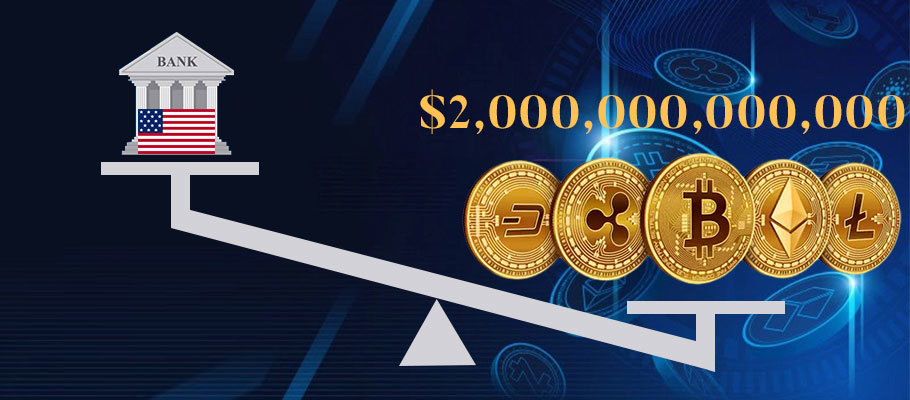
Published: April 9th, 2021
Things are on the up for the cryptocurrency market as it enters the second quarter, traditionally its most robust growth period.
Total market capitalisation crossed the USD 2 trillion mark this week and then kept going. At week's end total market cap had surpassed USD 2.05 trillion, up 4.8 per cent.
According to crypto analysts Bianco Research, the crypto market is worth more than the entire American banking system.
Crypto’s 100 per cent increase in value this year has edged it ahead of the S&P Composite 1500 Banks index, which tracks US banking institutions' stock performance.
If crypto’s market cap were to double again, an optimistic but not impossible scenario given what we’ve seen this year, it would be bigger than the combined US financial system, including banks, insurance companies, brokers, foreign exchange firms, and hedge funds.
Crypto has chipped away at gold’s market cap, too, hitting 27.7 per cent of the precious metal's cumulative value in circulation. The trend looks set to carry on as investors shift from their traditional safe haven to maximise short-term gains on the resurgent US Dollar.
Crypto’s undisputed leader, Bitcoin, crossed a market cap milestone of its own, holding above USD 1 trillion for 12 days in a row. That’s a new record, but for once, BTC isn't the whole story. The other names in the market have been responsible for most of crypto’s gains. Ethereum, which has hovered around the USD 1,500 mark for most of Q1, is now comfortably above USD 2,000.
Other big movers are Litecoin, up 10 per cent; Bitcoin Cash, up 12 per cent; while Ripple has jumped by close to 30 per cent.
Why is the crypto market so riled up? One reason is the US economy’s accelerating recovery. Stock markets are riding high, and crypto is capturing some of the spillover from positive sentiment and a more active investor community.
Both the Dow and S&P 500 set record highs this week on the back of encouraging job numbers from the US Department of Labor.
And that’s not the only economic good news buoying markets. PMI numbers show US manufacturing output set to reach a 37-year high.
Even tech stocks, which have been idling most of this year, are resurgent. Facebook gained 3.3 per cent to reach a new all-time high. Google’s price leapt by 4 per cent this week to carry it to a new all-time high.
In a note to investors, Citigroup analysts said that the shift to digital seen over the last twelve months 'may be more than a short-term reaction to COVID restrictions.' Even as lockdowns end and businesses re-open, consumers continue to make purchases online while working from home and choosing more digital services.
Amid the extended bull run this year has been a lot of volatility. Crypto markets have been shooting upward then dropping sharply as institutional investors and economic news acts on prices.
In early March, the global market capitalisation for crypto jumped by six per cent over three days to hit USD 1.72 trillion. Within a few hours, however, it had plummeted back to USD 1.66 trillion.
That was the biggest 1-day fall seen in 2021 and had some traders drawing parallels with an earlier plunge in Bitcoin and Ethereum prices seen in late February.
BTC has seen regular price jumps in the five- to six per cent range. In 2020 BTC’s price swings stayed in the two per cent range. Trading activity on exchanges has likely had a significant impact on pricing ups and downs. Numbers from analytics firm CryptoQuant in March indicated that Bitcoin supplies held on exchanges had fallen back to two-year lows.
The firm’s analysts said that suggested a lot of money was moving into some kind of cold storage. The overall effect was to restrict supply, which added to price pressure as the volume of Bitcoin accessible to the market was cut short.
Even as that was happening, one of Wall Street’s biggest names, JP Morgan, announced it was moving into the crypto space with the planned launch of a ‘cryptocurrency exposure basket.’ The service plans to give traditional investors indirect exposure to Bitcoin through companies like MicroStrategy or Tesla, which have already taken up prominent crypto positions.
JPM;’s timing can be explained in part by the Biden administration’s USD 1.9 trillion stimulus package and another planned USD 2 trillion in infrastructure spending. That has markets visibly buzzing, but in the background, the bank says interest from institutional players is what's really driving the move. High-net-worth individuals and family offices in China, have also been looking for ways to add BTC to their portfolios safely.
All of that could explain the current crypto bull run, but bear-ish headwinds have also been pushing back.
In March, the Federal Reserve offered markets USD 37 billion in US government bonds. However, interest was tepid, possibly signalling what's yet to come for the US and global economies.
Washington needs to sell bonds if it’s going to pay down some of America’s estimated USD 20 trillion in debt. The restrained market response signalled uncertainty from global markets. US government debt is a benchmark used by lenders to assess macroeconomic risk and is used in risk calculations for everything from mortgages to car loans and credit cards. Crypto prices dipped on the news.
If a government bond sale fails to generate interest, the issuing government might need to boost interest rates on the bond issue to make it more attractive. That puts pressure on Washington’s ability to raise money and tends to spook risk-averse investors.